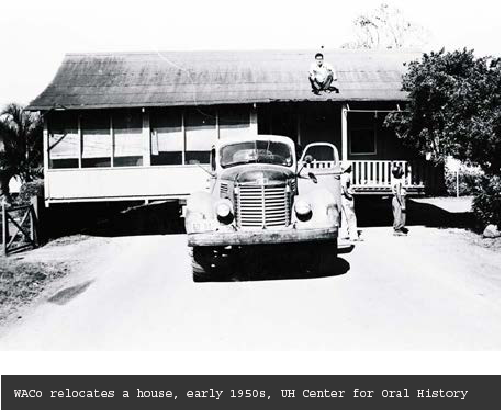Boyd Ready, Local Historian
Many of us have heard that a non-profit will renovate and expand the old plantation ‘Mill Camp’ for low-income housing. Only 67 of the original 300 homes remain, mostly in a state of poor repair. Dole Food’s commitment to retirees lifetime residence is expected to continue to be honored.
Of the nine named ‘camps’ the Waialua Agricultural Company (WACo) built and maintained, Mill Camp was the first and largest, followed by Kawailoa Camp. Crude work camps were, and still are, the normal way agriculture is done, especially for seasonal crops like strawberries, citrus, or tomatoes. Even today in agriculture, farmers just provide tents, portapotties, washstands and tarp canopies. Migrant wives crowd nearby town laundromats washing sleeping bags and work clothes. Most immigrants to Hawaii expected to return home soon with money in their pockets.
The Mill Camp became the first local economic engine for the North Shore. There was little in Haleiwa in the 1900 to 1920 days but a small resort hotel, a courthouse (1913), and a few services. A first (1899- 1905) workforce of unmarried men lived in crude dormitories and spent most of their six, ten- hour-day workweeks outdoors. A few married couples did arrive early and, by contract, were provided with a separate house. Soon ‘picture brides’ arrived to start families. Some big strikes (1904, 1909, 1920) shook things up, and management built real homes for most workers. By the mid-1930s indoor plumbing was installed, hospital and recreation centers built, and wages were always set higher than other plantations.
Hawaii’s first part-Hawaiian architect, Ted Vierra, who also designed Liliuokalani Church & the Honolulu Airport, provided standard designs with good ventilation. Five to seven thousand square-foot lots were sufficient for gardens and fruit trees. Most residents walked or rode bikes to work, shopping, the community center, post office and library. The Bank of Hawaii (1917), the Waialua Plantation grocery store, Fujioka’s Store (1905), and even a ‘shopping center’ near Long Bridge (Tanabe’s Hardware, a meat market, a pool hall, and a fish monger) were within a short walk of Mill Camp.
Plantation management kept careful records of house assignments, with better ones for good work performance. Houses were moved as needed, and painters, plumbers and carpenters worked at no charge to the residents. Rent was nominal or free until the late 1940s when ILWU negotiators preferred arm’s-length, paid tenancies to give workers more independence from management. Rents remained nominal, many at $42/month as late as 1996. The plantation’s worker housing at Mill Camp turned transient labor into the genuine community that Waialua remains today. Let us hope the low-income housing to be built will be as vital to our community as Mill Camp proved to be in the last century.
Haleiwa Waialua Historical Society is a 501(c)3 non-profit with over 200 members, a volunteer Board of Directors and committees. We seek artifacts, letters, documents, and photos for a new Heritage Exhibit to open April 26th. Email info@waialuahistoricalsociety.org or telephone 808-342-8557 to donate or loan items to the Society.



